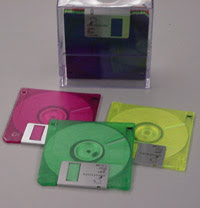How a computer stores information
- The computer stores information as a string of zeros (0) and ones (1)
- The standard string length is eight 0's or 1's in a row
- This standard length is called a byte
- A byte equals one character
- A character is a letter, number, or symbol - it is about any thing that can be typed on a keyboard
- There are 256 standard characters used by almost all computers
- Information size measurements
- Kilobyte (KB)
- One kilobyte equals about 1024 bytes
- 1KB is about 140 words, about a half page of typed double-spaced text (words only)
- Megabyte (MB)
- One megabyte equals about 1000 KB
- One megabyte equals about 1,000,000 bytes
- One megabyte equals about 500 pages of text, or one large book
- Gigabyte (GB)
- One gigabyte equals about 1000 MB
- One gigabyte equals about 1,000,000 KB
- One gigabyte equals about 1,000,000,000 bytes
- One gigabyte equals over 1,000 books of text
- Kilobyte (KB)
![]() Some Common Storage Devices
Some Common Storage Devices
Hard DriveThe hard drive is the primary device that a computer uses to store information. The hard drive stores programs, data files, saves files, and organizes files. The hard drive is located inside the computer case. The hard drive, magnetically stores data on stacks of rotating disks called platters.
Floppy Drive
The floppy drive stores and retrieves information on a floppy disk.
CD -ROM Drive CD-ROM is a device that reads information stored on a compact disc. CD-ROM stands for Compact Disc Read Only Memory. One CD is equal to the space in over 40 floppy disc.
Removable Hard Disk
A zip disk is a removable disk that holds a large amount of information. A zip disk can be used to achieve, protect and transfer large amounts of data.





No comments:
Post a Comment